Updated September 8, 2025: The construction of the Lesotho Highlands Water Project (LHWP) is taking shape with progress made on the Polihali dam. The dam is expected to boost water supply to Guateng and hopes are high as the dam progresses after years of delay. The dam in Mokhotlong is part of Phase II of the Lesotho Highlands Water Project. Moreover, it is advancing after years of planning setbacks. By the end of July 2025, about M18-billion (R18-billion) of the project’s M53-billion budget had already been spent. This is according to the Lesotho Highlands Development Authority (LHDA) spokesperson Mpho Brown. Once completed, the dam will create a reservoir covering more than 5000 hectares and holding 2,325 million cubic meters of water.
Moreover, it will boost annual water transfers to South Africa’s Guateng region from 780 to 1270 million cubic meters. It will also raise electricity production at Lesotho’s ‘Muela hydropower plant from 500GWh to 800GWh per year. Brown noted that about 30% of the main dam works were complete by July. The M2-billion Senqu Bridge, one of the largest structures under the project, was already 86% finished. Moreover, he added that the project had created jobs for roughly 14,000 people, though he cautioned that it could not significantly reduce Lesotho’s 30% unemployment rate. Southern African countries have been steadfast in implementing multipurpose dam projects with countries such as South Africa making progress on the Clanwilliam dam project in Western Cape.
Challenges Faced by the Lesotho Highlands Water Project
Despite its impact and significance, the Lesotho Highland Water project has not come without its setbacks. One of the major challenges is the delays in outstanding payments to continue the project’s progress. Koali Hlasoa, Senior Integrated Management Officer at LHDA Polihali Branch, said these were often linked to identification and ownership documentation problems. Moreover, family disputes or the absence of bank accounts also contributed to the problems. In some cases, beneficiaries had moved to South Africa for work, further slowing the process. Other than compensation, the project has been forced to manage environmental impacts. Chief Resident Engineer Ivano Vanzaghi, from the Matla a Metsi Joint Venture supervising the dam works noted these impacts. He noted that contractors had so far generated 20,500 litres of waste oil and nearly nearly 9,000 kilograms of other hazardous waste. Moreover, they generated over 34,000 cubic metres of wastewater and than 49 tonnes of general waste had been sent to landfill.
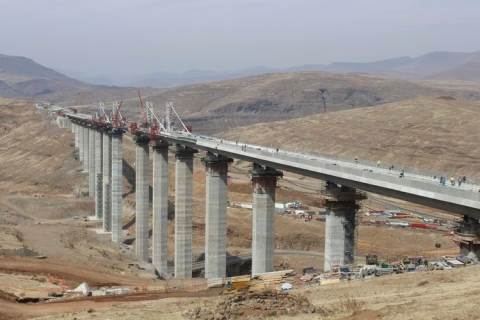
Communities have lodged complaints about dust, noise, air pollution, and water quality, while 40 environmental incidents have been reported. None were considered significant and the project supervisors are monitoring these reports, Vanzaghi said. However, delays have been harder to manage. The main dam fell behind schedule during site establishment, with slow excavation and hold-ups on tunnelling and spillway works. Vanzaghi noted that by late August, only 44 of 87 interior plinth blocks, the structures that secure the dam wall, had been completed. Water impoundment, once scheduled for January 2025, has now been pushed back nearly two years to November 2026. Full completion of the dam and related works is expected between August and September 2029.
July 2025 – Progress at Khubelu Bridge in LHWP Phase II
Another milestone has been reached in Lesotho Highlands Water Project (LHWP) Phase II, this time at the Khubelu Bridge, where the first 30m precast beam was successfully placed on the bridge piers. The beam lifting process required two cranes to position the beam in a high-precision operation. The pace set is only of 2–3 beams placed per day, and is led by highly experienced riggers and operators.
Once complete, the Khubelu Bridge will span approximately 270m across nine 30m spans and two abutments. An abutment is a point of junction that offers support to the bridge components. It’s one of two major bridges being constructed by the Concor–Nthane Brothers–M&K Bridges Joint Venture as part of Phase II of the LHWP.
According to the oversight authority for the project, the bridge design also accounts for the challenging high-altitude conditions and harsh winters of the Mokhotlong highlands, making this achievement even more significant.
Jan 2025 – Polihali to Katse Tunnel Boring Machine (TBM) recently broke ground on Phase II of the LHWP. The ground breaking ceremony held at Leribe marked two decades since the last TBM operations for Phase I of LHWP.
In attendance to mark the beginning of Polihali Transfer Tunnel works were teams from both divides of stakeholders. Also present were the firms involved in the project.
The tunnel boring process will extend 38km and stretch 5m in diameters. The Polihali Transfer Tunnel excavating by this machine will run from the Leribe side. The second TBM to start excavation from the Polihali side is expected on site by mid-2025. The TBM machine tagged named “the rat mole of 200 years” (Khoiti ea ‘Ngoaha Kholo2) will install a segmental tunnel lining, and is approximated to excavate at the rate of 20m/day.
Other main construction work planned for during the tunnel boring of the Polihali – Katse tunnel include:
- intake works
- outlet works
- installation of a reservoir gate shaft at the Polihali end
- installation of another gate shaft at the exiting Katse end

Once complete, the Polihali-Katse tunnel will serve the purpose of allowing for water flow (transfer) to the Katse end from the Polihali end. At both ends are reservoirs. The water capacity approximated at 1,270 cubic meters is expected to meet Gauteng province (SA) water needs.
Involved in the manufacturing process of the TBM was China-based company CCCC Tianhe. Also involve was Robbins who came in as the designer. MSKC JV will serve as the construction manager for the tunneling works. Also seeing contracts were Kopano Ke Matla JV, Basotho businesses, and over 10,000 persons for jobs.
Closure of bid submissions
Dec 16 – Next week will see the closure of bid submissions for the Professional Services for the Safety, Health, Environment and Quality Management (SHEQ) Audits for Phase II Main Works contract. As per the Implementation Progress and Result (IPR) Report released back in July 2024, the need for a SHEQ Auditor is paramount. The role of the auditor in the oversight of the performance in construction activities should be made official by the end of the year.
The most recent contract award for the Lesotho Highlands Water Project is the Professional Services for Design and Construction Supervision of Feeder Roads and Bridges contract. This was on the 5th of Dec. The contract identified with number 3005 is for the only part of the engineering scope that had not yet started. This part was slated to start on Feb 26 2024. The contract was awarded to Khubelu JV with the partners being: KBK Engineers (S.A), Bosh Projects (S.A), and Lesotho-based Pemahn Consulting. STRUTIE Group and Nala Environmental Services were tagged as sub-consultants. The contract cost capped at LSL 410m.
End of November saw the awarding of the Oxbow hydropower scheme Environmental and Social Impact Assessment (ESIA) contract. The contract winner was ELC, Greenway, and Green Gold JV. The project’s main authority, the Lesotho Highlands Development Authority (LHDA) awarded the contract for the one year work set to start early next year. The contract awarded on the 26th of Nov was capped at the cost of LSL 12m.
The scope of work in the ESIA contract is not limited to:
- Devising statements on the design, engineering, and construction phases of the project
- Evaluating and monitoring the compliance of the project to national and international environmental standards. These include the IFC standards and other environmental acts
- Development and conduction of studies, like the Environmental and Social Management Plans
- Conducting project assessment on the impacts to the environment and social structures
The Oxbow scheme was born out of a feasibility study that saw it fit to have a hydropower component in the Lesotho Highlands Water Project phase 2 (LHWP 2 ). The hydropower scheme lying on the Malibamatso River, and feeding into the ‘Muela substation, is set to produce up to 80MW of power for a 132 kV double circuit transmission.
Once the Oxbow hydropower scheme is complete, it will complement the ‘Muela hydropower plant completed in the Lesotho Highlands Water Project phase 1(LHWP 1). The two, among other energy projects, will hopefully reduce Lesotho’s energy imports and support internal energy production.
Just a week before the ESIA contract was awarded, the Professional Service for Resettlement Planning and Implementation for the Oxbow hydropower Scheme was canceled. Reasons for this were handled by the book, with a “Section 2” of the “Request for Proposal” cited in an official document.
Alongside the contract award to the Oxbow hydropower scheme, Sixty 15 JV also got a LSL 372m contract. The Sixty 15 JV contract includes the construction of Resettlement Villages and Replacement Housing in the Polihali Site Establishment Area. This was in the 25th of Nov.
Another recently awarded contract is that for the design and construction supervision for the Oxbow hydropower scheme. This was back in mid-October. Notable names in the contract include the Artelia, SMEC International, and GWC Consulting Engineers. The contract capped off at LSL 259m (£29m).
The LHWP 2 Implementation Progress and Result (IPR) report
According to the IPR, the project has a “highly satisfactory” rating for the Development Objective. This has been cited to the progress witnessed in the project despite the delays caused by financial, corruption and timeline overdue constrains. The recent award of contracts means fast-tracking of the project with the advance infrastructure work being substantially completed.
At this point, the project has been set for completion by 2029. The costs for the project were also a point of interest, with the LHWP having expended LSL 12 billion so far. Overall, no major risks to impede the implementation of the project have been cited.
A look back at the Lesotho Highlands Water Project (LHWP)
Over a year ago, Lesotho celebrated a significant milestone as construction commenced on water transfer works for Phase II of the LHWP. The works included the Polihali Dam, the Polihali Transfer Tunnel and the Senqu Bridge.
The ceremony took place in Malingoaneng Mokhotlong, attended by His Majesty King Letsie III of Lesotho, and President Cyril Ramaphosa of South Africa. Advanced infrastructure, including roads, bridges, power facilities, and housing, is almost complete, paving the way for the main construction phase.
The dam and tunnel construction is expected to take five years, with water transfer procedures scheduled to start in 2028. The Oxbow Hydropower Scheme, an integral part of Phase II, will begin generating power in 2029.
Other infrastructure arising from Lesotho Highlands Water Project
The Polihali Dam, similar to the Mohale Dam built during Phase I of the LHWP, will be a concrete-faced rockfill dam. It will create a reservoir across the valleys and tributaries of the Senqu, Khubelu, Mokhotlong, Moremoholo, and Sehong-hong rivers.
The reservoir will cover an area of 5053 hectares. The dam will include a spillway, a compensation outlet structure, and a mini-hydropower station. The Polihali Transfer Tunnel will transport water from the Polihali Reservoir to the Katse Reservoir using gravity. From Katse, the water will be delivered through a tunnel to the ‘Muela Hydropower Station, constructed during Phase I.
Moreover, the water will be channelled to the Ash River outfall outside Clarence in the Free State.
One of the notable features of Phase II is Senqu Bridge, which is one kilometer long and stands 90m tall. This bridge, the first of its kind in Lesotho, outshines the Mphorosane Bridge constructed during Phase I. It is the largest among the three bridges to be built under Phase II, spanning the Polihali reservoir.
The Polihali reservoir will add 2,325 million cubic meters of storage capacity to the LHWP. Additionally, the increased water flow will enhance power generation within Lesotho, reducing the country’s reliance on electricity imports. Phase II builds upon the success of Phase I, which was completed in 2003.
Also read: Senqu bridge construction hits significant milestone in phase II of LHWP
Lesotho Highlands Water Project’s background
Established through a Treaty signed between the Kingdom of Lesotho and the Republic of South Africa in 1986, the Lesotho Highlands Water Project (LHWP) is recognized as one of the world’s most successful trans-boundary water resources management schemes.
The LHWP is expected to put in place the physical and managerial capacity for Lesotho to harness the surplus water of the Senqu/Orange River and its tributaries in order to affect the delivery of specified quantities of water to the designated outlet into the Republic of South Africa and by utilizing such delivery system to generate hydropower in the Kingdom of Lesotho.
Funding the project
The South African government is responsible for the infrastructure development costs associated with the water transfer component, including livelihood restoration and compensation costs, as well as the costs of the environmental and public health programs.
The Lesotho government, on the other hand, is responsible for the infrastructure development costs associated with the hydropower component, including livelihood restoration and compensation costs, as well as the costs of the environmental and public health programs.
To date, 61 contracts have been awarded in the procurement process. Below is the project’s timeline of event preceding the most recent:
1986
In October, The Treaty on the Lesotho Highlands Water Project (LHWP) between the Government of Lesotho and the Government of the Republic of South Africa whose purpose is to provide for the establishment, implementation, operation, and maintenance of the Project, was signed in Maseru, Lesotho.
The LHWP was originally designed to include four phases implemented over a period of 30 years and expected to transfer about 70 m3/s of water to the Gauteng Province in South Africa. However, the Parties committed to Phase I only, with subsequent phases subject to agreement between the Parties. Phase I of the project was completed in stages, viz. Phase IA and Phase IB. It was designed to transfer an average of 25 cubic meters of water per second.
Phase IA comprised the construction of the Katse Dam, the concrete-lined transfer tunnel through which water flows under gravity to the ‘Muela Hydro- Power Station, the ‘Muela Power Station, the ‘Muela Dam, and the delivery tunnel through which the water discharges into the Ash River, north of Clarens in South Africa. Phase IB comprised the construction of the Mohale Dam and a concrete-lined gravity tunnel connecting the Mohale Reservoir with the Katse Reservoir.

An additional component of Phase IB was the 19m high Matsoku diversion weir and interconnecting tunnel to transfer water from the Matsoku valley to the Katse Reservoir.
1998
In January, water transfer from Phase I commenced.
1999
In January, hydropower generation was commissioned.
2003
Phase I was successfully completed.
2004
Phase I was commissioned.
2011
The agreement for Phase II was signed.
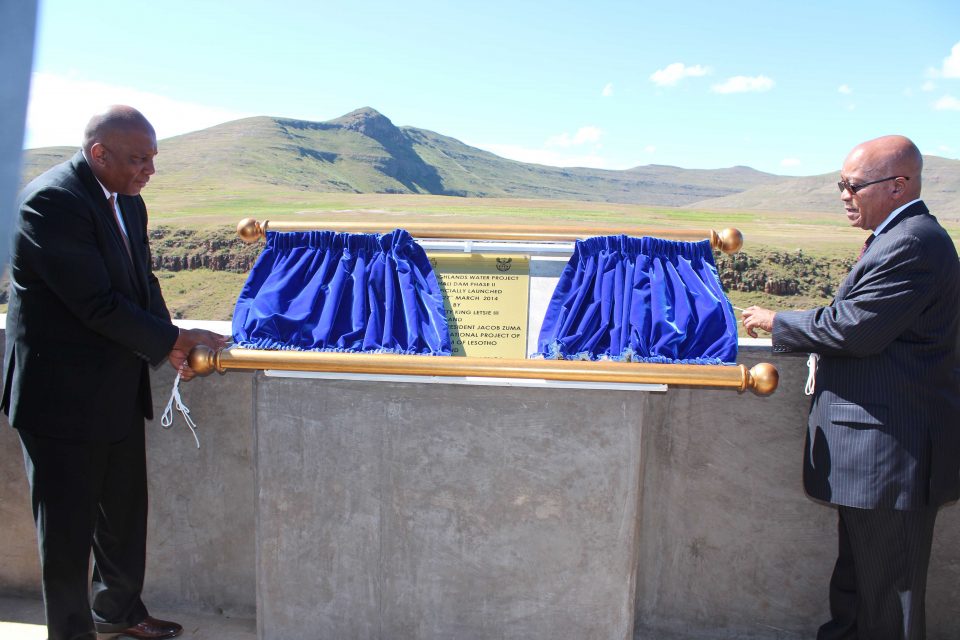
2013
In mid-2013, the Agreement was subsequently ratified by the two governments. This was followed by the appointment of the specialist Project Management Unit within the LHDA to oversee the implementation of Phase II and the practical commencement of this second phase of the Project.
As in the first phase, Phase II comprises water transfer and hydropower components. It comprises the Polihali Dam to be built downstream of the confluence of the Khubelu and Senqu Rivers in the Mokhotlong district in the Eastern highlands of Lesotho, a 38km long water transfer tunnel which will link the Polihali reservoir to the Katse reservoir and roads, bridges, high tension power lines and telecommunications systems, accommodation and construction facilities which form the advance infrastructure and which will largely be completed before the construction of the dam and tunnel commences.
Further feasibility studies for the hydropower component of Phase II have concluded that conventional hydropower is the more feasible option to meet Lesotho’s energy needs. In this regard, three potential sites were identified: two on the Senqu River and the third site at Oxbow on the Malibamats’o River. The plan is to start the design of the preferred option in 2021, construction in 2024, and commission it at the same time as the Water Transfer component, which is 2027.
June 2014
Second Phase of the Lesotho Highlands Water Project underway

The second phase of the bi-national project between the governments of Lesotho and South Africa was launched recently and was projected to cost US$1.3bn. The treaty signed between the two governments set relevant structures that will help implement the whole project.
The first phase of the project was split into 1A and 1B. The main physical features of Phase 1A are the Katse Dam, the transfer tunnel from Katse to Muela Hydropower station, The Muela Hydropower station and appurtenances, and the delivery tunnel to the border with South Africa. Phase 1B involved the construction of the Mohale Dams and the diversion tunnel to the Katse Dam.
The second phase of the Lesotho Highlands Water Project will comprise the construction of a 155-metre-high Polihali Dam and tunnels. According to the president of South Africa Jacob Zuma, the whole project is a good opportunity for both countries since it will create a good relationship between the states and also create employment.
The president also noted that through the project, South Africa will be able to get water given that it has scarce water resources. On the other side, Lesotho will be able to earn sufficient revenue to cater to its population. Since the inception of the project in 1998, Lesotho has benefited from road upgrades and linkages, and infrastructure development.
Completion of Lesotho Highlands phase II project set for 2023
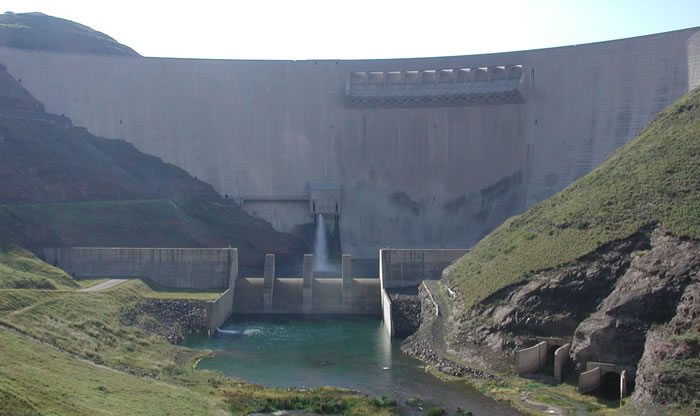
Phase II of the Lesotho Highlands Water Project (LHWP) which is estimated to cost US$1.06bn is set to be completed by mid-2023. This is according to the Lesotho Highlands Development Authority. The phase will entail the construction of the Polihali Dam, a tunnel, and several developments.
According to Mark Matchett the Executive Manager of the Phase II project, the procurement process of the project will run for a concentrated six to nine months time frame on which the authority hopes to have procured most of the contracts on design. By mid-2015 construction, contracts should have been set in place. Matchett added that the dam and tunnel designs would begin in the first quarter or second quarter of the coming year while the actual construction process will kick off in either the third or fourth quarter of 2015.
Sufficient rainfall would enable a minimal operating level by 2022. He also noted that projects such as environmental studies, resettlement, mitigation plans, and compensation had already begun and will be completed in late October or early November 2014. 2500 workers would help in the whole process and a township with existing lodges would be developed to cater for the accommodation of these workers.
Tente Tente, the divisional manager of the Phase II project, said an anti-corruption policy was in place to ensure that no underhanded tactics took place throughout the tendering process.
July 2015
Calls for Bidders for Phase II of the Lesotho Highlands Water Project
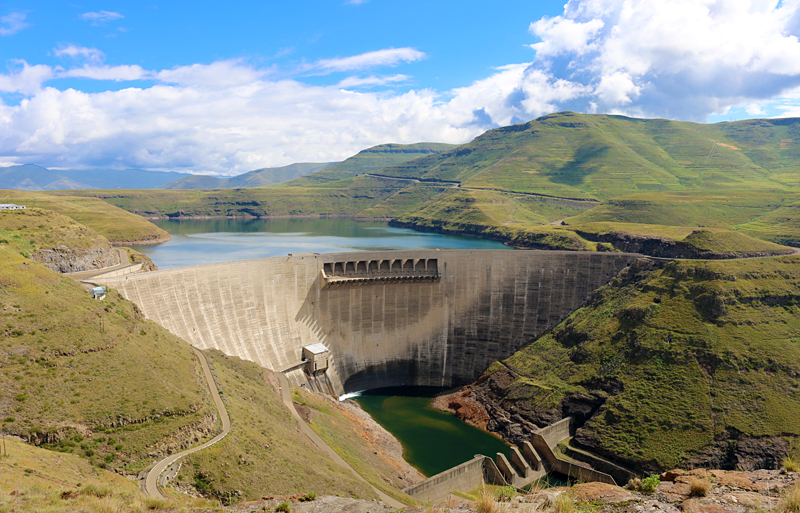
Professional services companies have been requested by the Lesotho Highlands Development Authority (LHDA) to submit their proposals for environmental and social impact assessment (ESIA) for the Polihali reservoir and associated infrastructure that are part of Phase 2 of the Bi-National Lesotho Highlands Water Project (LHWP).
The company that will be chosen will be tasked with environmental and social studies for the Polihali dam, Saddle dam and reservoir, quarries and borrow pits, the Eastern transfer tunnel, bridges, and housing project site establishments. The ESIA program was aligned closely with the program for design consultants for various project components.
The selected bidder will work with both external authorities and any other consultant responsible for social, environmental, cultural heritage, public health, and engineering services on the project. Some of the works that will go into the Phase 2 Lesotho Highlands Water Project include road works, tunnel diversions, power supply, bridge construction, and telecommunications.
Companies interested are expected to present their proposals by September 14, 2015. There will also be a compulsory pre-bid meeting and visiting the site of works taking place on July 15, 2015.
July 2016
Corruption claims hit South Africa’s billion-dollar water project

Water affairs and sanitation minister Nomvula Mokonyane is in the spotlight following a new report that she deliberately delayed South Africa’s billion-dollar water project allegedly to award contracts to a company she has a long-standing relationship with.
A report by City Press reveals that Lesotho Highlands Water Project has been delayed by over a year due to Mokonyane’s direct intervention, the report said, pushing its completion date to 2025, and pushing the price up to USD1.8 billion. This is according to a report by the City Press, noting that the Public Protector in South Africa will meet with Mokonyane over the issue this week.
The entire project is being funded by taxpayers. Senior officials told the City Press that the delay of South Africa’s billion-dollar water project was forced by Mokonyane so that consulting firm, LTE Consulting, could get involved. The damning report discloses that LTE has been awarded USD347m worth of contracts in water and sanitation over the last year. It was also found that the company had donated funds to support ANC.
The reports observe that LTE has reportedly been contacting and paying delegates involved with the project refusing to follow a tendering process but instead opting to meet Mokonyane directly. Subsequently, the bids for a number of tenders – from other companies – were rejected by the department soon thereafter.
The City Press report gives a detailed account of several hiring and firing practices undertaken by the minister and her department, allegedly with the aim of getting “favourable” people involved with the project. This included the removal of officials who had denied LTE Consulting tender opportunities. However, on her part, Minister Mokonyane has denied any wrongdoing.
She termed accusations levelled against her as false and malicious. She said that the delays in the project were to incorporate the much-needed “transformation”, to benefit black-owned companies.
Oct 2016
Completion of Lesotho Highland Water Project Phase II set for 2025
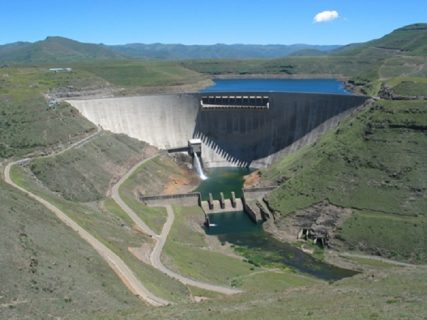
South Africa’s minister for water and sanitation Nomvula Mokonyane has said the Lesotho Highlands Water Project (LHWP) Phase II will be completed in 2025. The Minister made the announcement recently when she appeared before the Portfolio Committee on Water and Sanitation in Parliament.
Minister Mokonyane said the water project will make sure that the country is in a better position to deal with the effects that come with climate change. The minister said as a ministry and the government, they have learned a lot from Phase 1 which will help in the smooth implementation of Phase 11 The Lesotho Highlands Water Project Phase II, is the biggest water project of its kind due for implementation in the world currently, will benefit the national, regional, and international interests of both South Africa and Lesotho.
The Minister added that these benefits are not only limited to water supply; they extend to economic enhancement in line with Broad-Based Black Economic Empowerment principles. Meanwhile, Minister Mokonyane informed the portfolio committee that it will be gravely wrong to believe that the current water problems facing the country are a result of the delay in completing the LHWP.
“The project was never meant to be operational in 2016.”
The Minister blamed the severity of the current drought situation on the unfavourable climatic conditions and the high levels of the El Nino phenomenon that has hit the country’s shores causing visible knock-on dam levels, culminating in water shortages and the country experiencing its lowest rainfalls in 95 years.
She appealed to people to acknowledge that both South Africa and Lesotho have highly benefited from the completion of Phase I through the clean water supply, which South Africans enjoy. She, however, said that there has been a minimal benefit in terms of economic empowerment and skills and social development for the people of both countries.
Feb 2017
Bankruptcy claims hit Lesotho Highlands Water Project
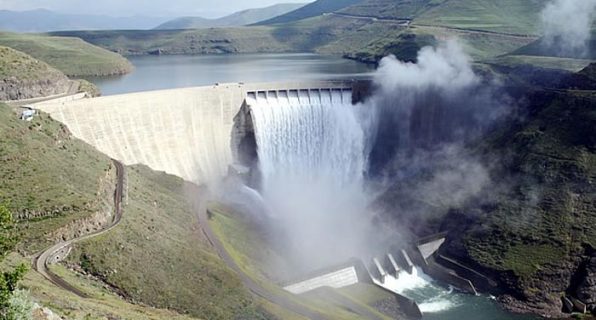
The Lesotho Highlands Water Project (LHWP) has recently hit a roadblock due to some allegations made by the city press accusing the Department of Water and Sanitation of South Africa of being bankrupt and having a debt amounting to a whopping US$3.2m making them unable of completing some crucial projects in the country.
The Minister of the Department of Water and Sanitation of South Africa, Nomvula Paula Mokonyane has however denied these allegations through a statement from her office saying that the department is not in debt arguing that they still have enough funding that will last them till the end of the financial year.
“The department is not in debt where we stand, we still have sufficient funding until the end of the financial year,” Nomvula Mokonye confirmed. The prosecutor’s office is however currently investigating the project that is worth approximately US$ 190m. Mokonyane’s office further insisted that the minister rejects the allegations as unfounded, without factual basis, and refuses to be intimidated by such actions.
The citizens can only wait for a report from the ministry so as to finally know the outcome but according to the city press, an official at the treasury has alleged that the project and contract management in that department has completely collapsed with the shocking revelation of irregularities on the expenditure of an additional US$190m Lesotho Highlands Water Project (LHWP) is an ongoing water supply project with a hydropower component, developed in partnership between the governments of Lesotho and South Africa.
The mega project comprises a system of several large dams and tunnels throughout Lesotho and South Africa. In Lesotho, it involves the rivers Malibamatso, Matsoku, Senqunyane, and Senqu while in South Africa, it involves the Vaal River making it Africa’s largest water transfer scheme.
March 2017
LHDA holds workshop to address LHWP Phase II’s compensation policy
A review workshop was recently held by the Lesotho Highlands Development Authority (LHDA) following approval of the Lesotho Highlands Water Project’s (LHWP) Phase II Compensation Policy. The Phase II Compensation Policy as developed by the LHDA was drawn up with considerations on lessons learned from Phase I of the project, while also enabling stakeholder participation in its development.
Lesotho’s water minister, Kimetso Mathaba confirmed that the policy implementation would be a platform for enabling participants to share an understanding of the document. This is with the hope that the forum will provide clarity on compensation issues that might have to be discussed or explained to communities affected by the implementation of the LHWP.
At the workshop, Mathaba said the Constitution of Lesotho and the Treaty that established the LHWP require that all losses suffered by communities, as a result of the implementation of the project, be compensated. The LHDA chief executive, Refiloe Tlali, also delivered a presentation at the workshop, affirming the LHDA’s commitment to the restoration and improvement of the livelihoods of the communities affected by the project.
She also mentioned LHDA’s engagement of a consultant to assist with the identification of the livelihood restoration and diversification options that will be planned with affected households and communities from an early stage in the Phase II program. This aims to promote sustainability.
The workshop was attended by the principal chiefs of Mokhotlong and Malingoaneng, ministers from Mokhotlong constituencies, and representatives from the offices of the District Administration and District Councils from Mokhotlong, Leribe, and Thaba-Tseka. The upcoming construction of Phase II of the LHWP will see the building of the Polihali Dam.
The wall is planned to be 165 meters high and the construction of a 38-kilometer-long tunnel will transfer water from the Polihali reservoir to the Katse reservoir, resulting in the construction of the hydropower scheme.
Jun 2017
Work on phase two of the Lesotho Highlands Water Project to officially start
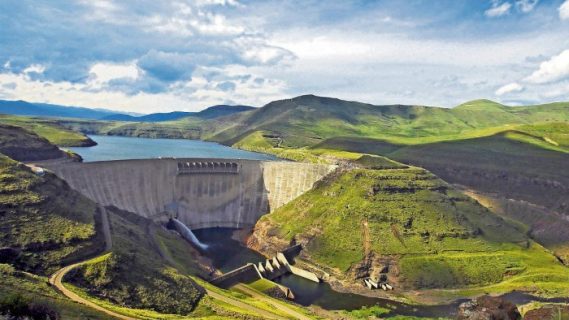
As the second phase of the Lesotho Highlands Water Project nears commencement, construction tenders worth between $78,000- $78m for the same will be advertised soon. This is according to the executive manager of the project, Mark Matchett.
The project which happens to be a joint venture between SA and Lesotho will not only supply water to Gauteng but also generate work in the thousands for the people living around the area. The first phase was initiated thirty years ago, with water and electricity supply to South Africa and Lesotho respectively from the Katse and Mohale dams.
The second phase will see an increase in the water supplied to South Africa from 780m – 1.37b cubic meters per year. Moreover, Lesotho will get a hydropower project which will serve the purpose of making it self-sustainable in electricity. Trans Caledon Tunnel Authority manages the project for SA.
The Lesotho Highlands Development Authority manages it for Lesotho. Matchett said there would be about 20 construction contracts, including for roads, bridges, bulk power lines, telecommunications, resettlement of about five villages, the dam, and 38km of transfer tunnel. The work is set to begin in two years’ time for it to be complete by 2024. The transfer tunnel will begin a year later to be completed in 2025.
Funding for the project, according to Trans Caledon executive of project finance and treasury Nhlanhla Nkabinde will be sourced from new JSE-listed bonds as well as the tariff levied on users of the water and a levy on the mining industry to fix acid mine drainage. Trans Caledon issued bonds more than 20 years ago to fund the first phase and would extend the program for phase two.
Tente Tente, the phase two divisional manager, said Lesotho bidders would be given preference, followed by those from SA and then the Southern African Development Community.
July 2017
LYMA consulting engineers clinches $32.9m water project deal
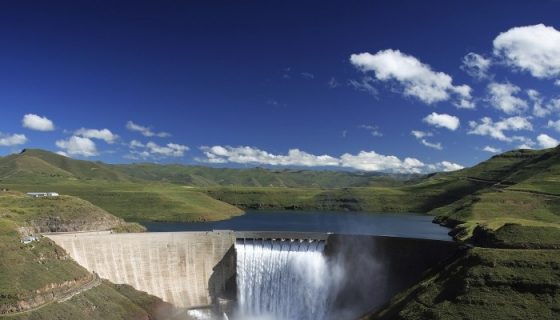
LYMA Consulting Engineers is part of a consortium that was awarded the contract for the design and construction supervision of the Polihali Dam. The tender was awarded in terms of the second phase of the Lesotho Highlands Water Project LYMA Consulting Engineers (LHWP).
The Lesotho Highlands Development Authority (LHDA), Chief Executive Officer Refiloe Tlali revealed earlier this week that LYMA had been given the contract which is the highest award to date in the bi-national project. The Matla a Metsi consortium is a joint venture which includes LYMA, GIBB (Pty) Ltd and Mott MacDonald Africa (Pty) Ltd (both from South Africa), and Tractebel Engineering SA/ Coyne et Bellier from France. YMA reportedly holds 18% of the shares in the consortium.
According to Ms Tlali, the joint venture is expected to review project information and all it entails. She further added the contract was expected to be completed in the next 18 months. The LHWP project entails harnessing the waters of the Senqu/Orange River in the Lesotho highlands through the construction of a series of dams for the mutual benefit of the two countries.
Phase I of the LHWP, consisting of the Katse and Mohale dams, the ‘Muela hydropower station, and associated tunnels were completed in 2003 and inaugurated in 2004. Phase II of the LHWP is currently in progress. The water transfer component of Phase II comprises an approximately 165m high concrete-faced rock-fill Dam at Polihali downstream of the confluence of the Khubelu and Senqu (Orange) Rivers and an approximately 38km long concrete-lined gravity tunnel connecting the Polihali reservoir to the Katse reservoir.
Other Phase II activities include advanced infrastructure and the implementation of environmental and social mitigating measures. The hydropower component of Phase II, which is currently under further feasibility studies, may include a pumped storage scheme, conventional hydropower such as the expansion of the ‘Muela infrastructure, or new greenfield sites.
Its exact form will be determined upon the completion of further feasibility studies. Phase II is expected to be substantially complete by the end of 2024. She said the dam impoundment process was expected to take place during the rainy season in 2023 so that water transfer to South Africa would commence at the end of 2025.
Oct 2017
Tenders for the construction of the LHWP 2 are opened

Construction of Phase 2 of the Lesotho water project will begin next year. This is following the advertisement of the first of 20 tenders earlier this week. Phase 2 comprises a wide range of small and large contracts. Furthermore, Lesotho Highlands Development Agency (LHDA) Divisional Manager of Phase 2, Tente Tente, says several more tenders will undergo circulation between now and mid-2019.
Infrastructure components
The Polihali northeast access road is one of the first advanced infrastructure components to go to tender. The tender was advertised at the end of September and the bids should meet the deadline of December 17. The LHDA states that preference will be given to Lesotho nationals and South African nationals. Professionals from the Southern African Development Community region will also undergo consideration.
International bidders are subject to conditions on quality, competitiveness, transparency, and cost-effectiveness. Tente said that the first quarter of 2018 will mark the start of a six-year construction period for the second phase of the project. The majority of the advanced infrastructure components are to reach completion before the construction of the main Phase 2 works.
This includes the Polihali dam and transfer tunnel. The water transfer component of Phase 2 of the LHWP will cost US $1.7m at completion in 2025. The project also entails a hydropower component. The LHDA states that skills and technology transfer are set in the locating and contract documents.
At the height of the construction period, Phase 2 will provide employment for between 2 000 and 3 000 Basotho. Phase 2 will increase the current supply rate of 780 million cubic meters a year incrementally to more than 1.26Bn cubic meters a year.
Phase 2 of the Lesotho Highlands Water Project to commence
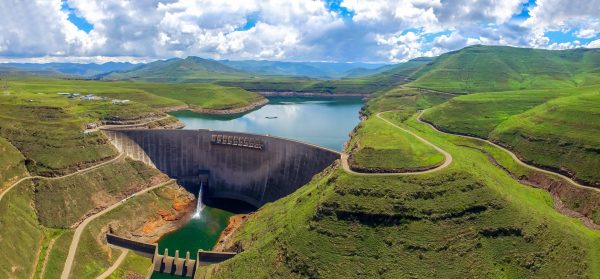
The Construction of the Polihali Dam, an integral part of Lesotho Highlands Water Project Phase 2 is set to commence soon, and its impoundment should start in the second half of 2023. The water project which includes the Polihali-Katse transfer tunnel is a combined effort of both the governments of South Africa and Lesotho. Phase 2 of the LHWP is a result of the successful completion of Phase 1 in 2003. Its estimated cost is a total of US $1.3bn.
Polihali Dam
The Dam will be built downstream of River Seqhu and River Khubelu. It will have a 163.5-m-high concrete-faced rock-fill embankment dam wall with a concrete side-channel spillway. The water supply will only begin once the reservoir has filled completely. The Projected date of completion has been set to 2024 upon which expected water supplied to South Africa would be an estimated 780 million cubic meters yearly over the subsequent 20 years.
The crest length will be 915 m, with a free-standing compensation outlet tower. Polihali-Katse Transfer Tunnel. This tunnel will be 38.2km long with an average diameter of 5m. The first phase of this project consisted of the Katse and Mohale dams, and the Muela hydropower station which was completed in 2003 and inaugurated in 2004. Katse Dam is situated about 2,000m above sea level and is one of the world’s 10 largest concrete arch dams in terms of volume.
It is also the highest dam wall in Africa. The Muela hydropower project is fed by the Katse reservoir via a 45 km-long concrete-lined transfer tunnel which has a diameter of about 4.35m. The major benefit of this project is that it generates close to 85% of Lesotho’s electricity.
April 2019
Phase two of the Polihali diversion tunnels in Lesotho set to begin in April
Lesotho Highlands Development Authority (LHDA) has announced the winning contractor to construct the Polihali diversion tunnels as it begins implementation of phase two of the Lesotho Highlands Water Project (LHWP II). LHDA awarded SCLC Polihali Diversion Tunnel joint venture (JV) the contract for the project and is expected to be on-site this April 2019 to begin construction works ahead of the 18 months deadline. SCLC Polihali Diversion Tunnel joint venture is made up of South African branches of CMC di Ravenna, Salini Impregilo, CMI Infrastructure, and Lesotho-based LSP Construction. “The diversion tunnels are important to facilitate the construction of the Polihali dam. This construction is a crucial element of the advanced infrastructure works, which began towards the end of 2018 with the awarding of the contracts for the civil work at Katse and Mokhotlong Polihali North East access road. The project is estimated to cost US $36m,” said LHDA divisional manager Tente Tente. Mr. Tente adds that the advanced infrastructure will largely be completed before construction works on the Polihali dam begins and the Polihali to Katse water transfer tunnel.
Scope of Implementation on the Polihali Dam
The Polihali dam, it will be built downstream of River Seqhu and River Khubelu. It will have a 163.5-m-high concrete-faced rock-fill embankment dam wall with a concrete side-channel spillway. The water supply will only begin once the reservoir has filled completely. Two diversion tunnels will be constructed to divert water from the Senqu River. The construction of the two tunnels will increase its capacity to carry floods while also providing flexibility to work in one tunnel while the river flows in the other. The tunnels which are 7 meters in diameter and almost 1 km in length and another 9 meters in diameter and almost 1 km long will run parallel to each other from the intake point to the outlet downstream of the dam. Additionally, the tunnels will be excavated by drill and blast method and will be supported by rock bolts and shotcrete, as required. The diversion tunnels were designed by Metsi a Senqu-Khubelu Consultants JV who are also the supervisors of the project. The project which delivers water to the Gauteng region of South Africa and generates hydroelectricity for Lesotho will increase the current water supply rate of 780 million cubic meters a year to more than 1.27-billion cubic meters a year and also increase electricity generation.
Aug 2019
Road infrastructure for Phase II Lesotho Highlands Water Project begins

Road infrastructure for Phase II Lesotho Highlands Water Project has commenced. The Lesotho Highlands Development Authority (LHDA) announced the report and said that they have awarded two separate contracts for the construction of the Polihali Western Access Road (PWAR) (West and East) Joint Venture and Rumdel/AC JV respectively.
Phase II of the Lesotho Highlands Water Project builds on the successful completion of Phase I in 2003. It delivers water to the Gauteng region of South Africa and utilizes the water delivery system to generate hydroelectricity for Lesotho. Phase II will increase the current water supply rate of 780 million cubic meters per annum incrementally to more than 1,270 million cubic meters per annum.
Phase II Lesotho Highlands Water Project
LHDA pointed out that the roads are the fifth and sixth of approximately a dozen advanced infrastructure contracts for the LHWP. Construction work for PWAR is expected to be completed by 11 June 2021 while PWAR East works which commenced on 23 July 2019 are expected to be completed by 22 June 2021.
The PWAR Western section is a 21.44km long road between Ha Seshote and Semenanyane River while the Eastern section is a 32.86km long road between the Semenanyane River and the Polihali Dam site. The PWAR will be constructed into an engineered standard, two-lane surfaced road with surfaced shoulders and passing lanes. Some sections of the road follow an existing gravel track that will be upgraded to an engineered surfaced road.
Other sections of the road follow a new route to improve the vertical and horizontal alignments. There will also be the construction of three new bridges including a new bridge at the Matsoku River, a stormwater drainage system and road ancillaries also form part of the PWA road construction works.
“The quality roads constructed under Phase II will not only provide access to the Polihali Dam construction site but will also significantly influence sustainable economic growth through tourism and industrial development,” said Tente Tente, acting CE of the LHDA.
Oct 2019
LHDA awards contract for construction of 132kV power line from Matsoku to Polihali
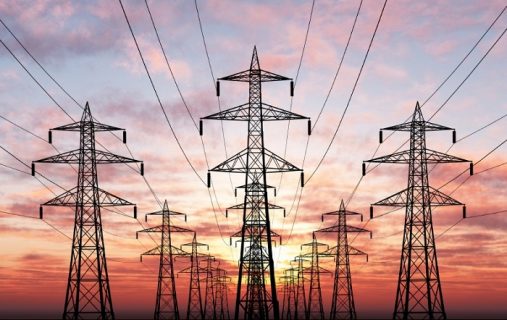
The Lesotho Highlands Development Authority (LHDA) has announced that it has awarded Mkhulu Electro Distribution Projects (Pty) Ltd the contract for the construction of a 132kV power line from Matsoku to Polihali.
Mkhulu EDP is a South African-based project management company with extensive experience in overhead transmission line construction and civil engineering projects across the region.
Work under this contract
As per this agreement, Mkhulu Electro Distribution Projects (Pty) Ltd is expected to construct a new 132kV line between the existing Lesotho Electricity Company (LEC) transmission network in the Matsoku Valley and the Polihali Dam construction site, a distance of approximately 38 kilometres.
The contractor is also supposed to upgrade the existing LEC lines from Ha Lejone to Matsoku, and Maputsoe to Katse. The upgrade includes the installation of insulation and shielding earth conductors. Additionally, Mkhulu Electro Distribution Projects (Pty) Ltd will undertake the installation of an optical ground wire (fibre) communication line from Maputsoe to Katse and Polihali.
This line is planned to enhance communication in the project area. This project is an essential component of the Lesotho Highlands Water Project Phase II whose implementation commenced in September last year with a two-year execution timeframe.
Lesotho Highlands Water Project Phase II
The Phase II of the Lesotho Highlands Water Project was inspired by the successful completion of Phase I in 2003. The latter delivers water to the Gauteng region of South Africa and utilizes the water delivery system to generate hydroelectricity for Lesotho. Phase
II is expected to increase the current water supply rate of 780 million cubic meters per annum to more than 1 270 million cubic meters within the same period. Furthermore, it will intensify the quantity of electricity generated in Lesotho and is an auxiliary step in the process of securing an independent electricity source for the region.
Nov 2019
Lesotho launches Polihali Dam project
Lesotho has launched the construction of the Polihali Dam in a ceremony that brought together dignitaries from the Kingdom of Lesotho and representatives of the South African government. The Polihali Dam will be useful to both countries.
The project
The dam will store part of the waters of the Orange River (Senqu) and the Khubelu River. Its concrete rockfill wall will be 165m high with a ridge length of 921m and a ridge width of 9m. At its base, the slope will be 470m wide. The dam will have a spillway with a concrete side-channel spillway.
The Lesotho Highlands Development Authority (LHDA) estimates that 13 million cubic meters of rock will be extracted from the dam site and compacted for backfill construction. The Polihali dam will form a reservoir on the Orange and Khubelu Rivers covering an area of 5,053 hectares, with a total storage capacity of 2,325 million cubic meters.
It will be supported by a saddle dam, an auxiliary reservoir built to contain the reservoir created by a primary dam.
Lesotho highlands water supply program
The construction of the Polihali Dam is part of Phase II of the Lesotho Highlands Water Supply Project. It is a program to build several dams in Lesotho to capture the waters of the upper Orange River Basin and reverse part of its flow in order to provide South Africa and in particular the Johannesburg region, with drinking water.
Two tunnels are under construction to supply the Polihali dam. The work is being carried out by SCLC Polihali Diversion Tunnel Joint-Venture, a joint venture formed by the Italian companies Salini Impregilo and Cooperativa Muratori Cementisti CMC di Ravenna, as well as the South African company CMI Infrastructure and LSP Construction from Lesotho.
Part of the water from the Polihali dam will be transferred to the Katse Dam in South Africa via a tunnel while some of the water will be used to generate electricity for Lesotho.
Repair works on the Lesotho Highlands Water Project tunnel completed
Repair works and installation of equipment on the Lesotho Highlands Water Project (LHWP) tunnel have been completed. The Department of Water and Sanitation (DWS) made the announcement and said that the completion paves the way for the transfer of water from Lesotho in December.
The tunnel was shut down for purposes of inspection and maintenance in October and will continue until 30 November 2019. During this period, the tunnel was drained and no water transfers to the Vaal River System are possible.
Lesotho Highlands Water Project
The project which happens to be a joint venture between SA and Lesotho will not only supply water to Gauteng but also generate work in the thousands for the people living around the area. The first phase was initiated thirty years ago, with water and electricity supply to South Africa and Lesotho respectively from the Katse and Mohale dams. The second phase will see an increase in the water supplied to South Africa from 780m – 1.37Bn cubic meters per year.
2020
In July, The pre-qualification for the Polihali Dam and Polihali Transfer Tunnel construction was cancelled and preparations for open tender are currently in progress. Later the same year, three additional geotechnical investigations contracts for the Polihali transfer tunnel were awarded.
Aug 2020
Phase 2 of the Highlands Water Project in Lesotho launched
The Government of the Kingdom of Lesotho launched the second phase of the Highlands Water Project (LHWP). In the second phase, the government plans to build a concrete rockfill dam with a 165m wall. The Polihali Dam will be built downstream of the confluence of the Orange-Senqu and Khubelu Rivers in the Mokhotlong District of Lesotho.
The dam will allow the formation of a reservoir on the Orange and Khubelu Rivers over an area of 5,053 hectares, with a total storage capacity of 2,325 million m³. It will be supported by a saddle dam, which is an auxiliary reservoir built to confine the reservoir created by a primary dam, either to allow for higher water elevation and storage or to limit the extent of the reservoir in order to increase its yield.
Highlands Water Project (LHWP)
Highlands Water Project (LHWP) is a bi-national project divided into several phases. It was established by the 1986 treaty between the governments of the Kingdom of Lesotho and South Africa. The project will involve raising a low point on the margin of the reservoir to prevent water from bypassing the Polihali dam.
This saddle dam will have a height of 45m, a crest length of 603 m and a crest width of 6.5m. Part of the water from the Polihali Dam will be transferred to the Katse Dam in South Africa via a tunnel. With its 185 m height and 710m width, the Katse Dam is currently supplied through a tunnel that connects it to the Mohale Dam.
It is used for drinking water supply and agriculture in the Gauteng province of South Africa, in accordance with the 1986 agreements with Lesotho. South Africa, which is co-financing the LHWP with Lesotho, is expected to see the benefits of the project from November 2026.
Lesotho Highlands Water Project: Underground tunnelling works get on
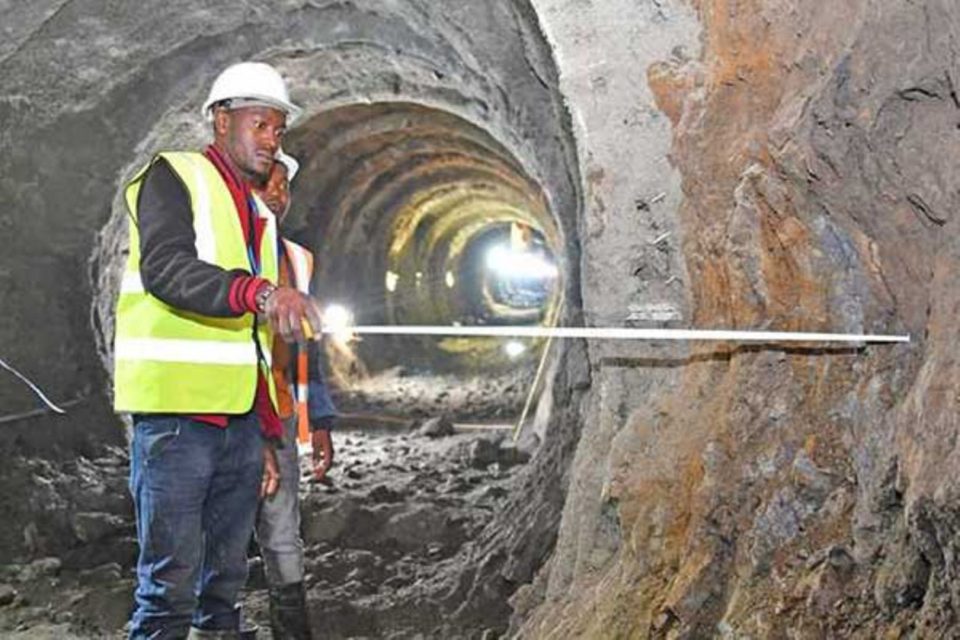
Underground tunnelling works at the Lesotho Highlands Water Project (LHWP) site inside the two Polihali diversion tunnels are progressing well. Excavations of the outlets are reportedly advancing at a pace of about 6 meters a day per tunnel. This will be followed by the tunnels’ concrete lining works that include concrete casting and reinforcement which have already started on tunnel one.
Both tunnels’ intake and outlet portal drives have been reinforced with sprayed concrete and rock bolts, and preparatory works for the concrete inlet structure are also continuing. The tunnels, one of which measures 7 meters in diameter and almost 1 kilometre in length while the second measures 9 meters in diameter and also almost 1 kilometre in length, run parallel to each other from the intake point to the outlet downstream of the Polihali dam.
Preparation for the construction of the Polihali dam
The tunnels are being excavated in advance of the construction of the Polihali dam in the second phase of the Lesotho Highlands Water Project in a bid to reduce the dam construction window.
The scope of the work for the Polihali dam according to the government of Lesotho mainly includes the construction of a concrete rockfill dam with a 165m wall. The Dam will be built downstream of the confluence of the Orange-Senqu and Khubelu Rivers in the Mokhotlong District of Lesotho. It will allow the formation of a reservoir on the Orange and Khubelu Rivers over an area of 5,053 hectares, with a total storage capacity of 2,325 million m³.
The dam will be supported by a saddle dam, which is an auxiliary reservoir built to confine the reservoir created by a primary dam, either to allow for higher water elevation and storage or to limit the extent of the reservoir in order to increase its yield. Impoundment of the Polihali reservoir is expected to start in 2024, with water delivery planned to start in 2027.
2021
In March, ten advance infrastructure contracts were awarded. Construction activities are at varying stages with some contracts planned to be completed in 2021.
March 2021
Lesotho Highlands Water Project (LHWP) to be operational in 2027
South Africa’s long-awaited US $2.46bn Lesotho Highlands Water Project (LHWP) is expected to be operational in 2027. According to the Department of Water and Sanitation, the building of roads, accommodation, and electricity installations had begun, and border closures due to COVID-19 would not have a “material impact.
“COVID-19 disruptions are not expected to have a material impact on the planned completion date of project works and commencement date of water delivery to South Africa, in early 2027,” said the department.
Lesotho Highlands Water Project (LHWP)
Created in 1984, the LHWP was designed to have five phases over 30 years and transfer up to 2 billion cubic meters of water annually from Lesotho to South Africa’s commercial hubs and industries like Sasol and Eskom.
Phase one started delivering water in 1996. Phase two, which includes the 2.3 billion cubic meters Polahli Dam and a 1,200MW hydroelectric plant in Lesotho, was meant to be complete by 2020. Tunnelling for the project was carried out late last year.
The Dam is being built downstream of the confluence of the Orange-Senqu and Khubelu Rivers in the Mokhotlong District of Lesotho. It will allow the formation of a reservoir on the Orange and Khubelu Rivers over an area of 5,053 hectares, with a total storage capacity of 2,325 million m³. The dam will be supported by a saddle dam, which is an auxiliary reservoir built to confine the reservoir created by a primary dam, either to allow for higher water elevation and storage or to limit the extent of the reservoir in order to increase its yield.
According to the Department, the over US $4.1bn needed by the Trans-Caledon Tunnel Authority (TCTA), South Africa’s state-owned company responsible for the Lesotho project, would be generated through further debt issuance.
Tender for construction of LHWP II Senqu Bridge ongoing until 18th June
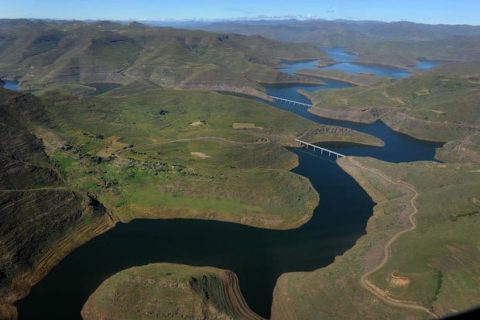
The tender for construction of Phase II of the Lesotho Highlands Water Project (LHWP) Senqu Bridge construction is ongoing until 18th June. The bridge will be the first extradosed bridge in Lesotho, which combines both prestressed box girder and cable-stayed elements in an efficient design.
The construction of LHWP II Senqu Bridge is almost 100m high and has a length of 825m. This is the largest of the three bridges that will be constructed under Phase II to span the Polihali reservoir.
The Polihali reservoir in the valleys and tributary catchments of the Senqu and Khubelu rivers, which will be formed by the construction of the Polihali Dam, will have a surface area of approximately 5000 hectares. Besides the three major bridges, the restoration of access across the reservoir also necessitates the construction of new approach road sections to the bridges that tie into the existing A1 road.
The A1 is the main road between the Mokhotlong district in the northeast of the country and the capital, Maseru.
Senqu Bridge
According to Lesotho Highlands Development Authority (LHDA)’s Chief Executive Tente Tente, experience and expertise are crucial in delivering a sophisticated, technically challenging project of this kind, which will be one of the few for the LHWP and Lesotho. “Based on our experience with other major works tenders, we are confident that our call for tenders will attract the right mix of expertise and experience,” he said.
“With its unique features, the Senqu Bridge will not only form part of the safe and efficient road infrastructure network constructed under Phase II but will be a major tourist attraction contributing to long-term benefits in stimulating sustainable economic growth,” he added. Due to the deep valley and the inaccessible nature of the area where the Senqu Bridge will be built, the deck of the bridge will be constructed incrementally from both abutments.
The in-situ segment midspan of the centre span will connect the two parts to form a continuous deck. This construction method will minimize disturbance to the surrounding area and increase workers’ safety. It is envisaged that a steel launching nose will not be required. The pier shape is ideal to be constructed with sliding formwork. Work on the bridge design started in 2018, led by Zutari, formerly Aurecon Lesotho. Zutari also designed the Mabunyaneng and Khubelu bridges.
Zutari will also supervise the construction of the three bridges. Specific information on the requirements and conditions of the tender is available on the LHDA website.
May 2021
South Africa’s TCTA raises US $1bn for Lesotho Highlands Water Project
South Africa’s Trans-Caledon Tunnel Authority (TCTA) has raised US $1bn in capital markets to continue construction of the Lesotho Highlands water project. The authority needed guarantees from the National Treasury before it could raise private funding for the project.
According to the Department of Water and Sanitation (DWS) Minister, Lindiwe Sisulu, the department now has the resources and the guarantees and it is ready to provide water security in the country.
The raised funds will facilitate the completion of phase 2 of the Lesotho Highlands water project, which involves the construction of several dams including the Polihali Dam to be built downstream of the confluence of the Khubelu and Senqu Rivers in the Mokhotlong district in the Eastern highlands of Lesotho. A 38km long water transfer tunnel that will link the Polihali reservoir to the Katse reservoir will also be built.
Lesotho Highlands Water Project
The Lesotho Highlands Water Project (LHWP) is expected to put in place the physical and managerial capacity for Lesotho to harness the surplus water of the Senqu/Orange River and its tributaries in order to affect the delivery of specified quantities of water to the designated outlet into the Republic of South Africa and by utilizing such delivery system to generate hydropower in the Kingdom of Lesotho.
In addition, each Party has the opportunity to undertake ancillary developments in its territory. Established through the 1986 Treaty signed between the Governments of the Kingdom of Lesotho and the Republic of South Africa, the Lesotho Highlands Water Project (LHWP) is recognized as one of the world’s most successful transboundary water resources management schemes. Please give us the historical background.
Aug 2021
Lesotho launches tender for construction of Polihali Dam
The Lesotho Highlands Development Authority (LHDA) has launched a tender for the construction of the Polihali Dam. The authority is seeking a company to develop the water reservoir and is targeting both national and international companies. Those interested have until November 12th, 2021 to submit their proposals.
“Our objective with this latest development is to attract suitably qualified companies with the capacity, experience, and resources to undertake the construction of the Polihali dam within the set time frame and with the required quality,” said Tente Tente, the LHDA’s managing director.
Polihali dam
The Polihali dam will be built downstream of River Seqhu and River Khubelu. The dam’s concrete rockfill wall will be 165m high with a ridge length of 921m and a ridge width of 9m. At its base, the slope will be 470m wide. The dam will have an overflow with a concrete side-channel overflow.
According to LHDA, approximately 13 million cubic meters of rock will be extracted from the dam site and compacted for backfill construction. The Dam will form a reservoir on the Orange River and Hubeilu River, with an area of 5,053 hectares and a total storage capacity of 2,325 million cubic meters. It will be supported by a saddle dam, an auxiliary reservoir built to contain the reservoir created by a primary dam. Polihali Dam is part of Phase II of the Lesotho Highlands Water Supply Project.
It is a program to build several dams in Lesotho to capture the waters of the upper Orange River Basin and reverse part of its flow in order to provide South Africa and in particular the Johannesburg region, with drinking water. Two tunnels are already under construction to supply the Polihali dam.
Lesotho awards contract for construction of LHWP II bridge project
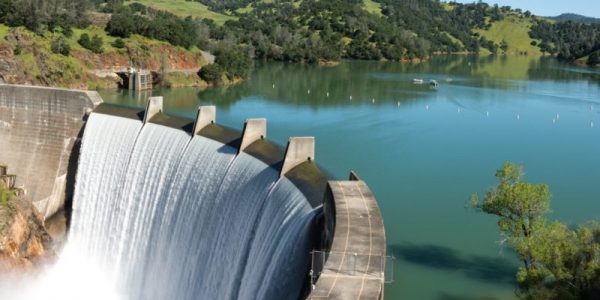
Lesotho Highlands Development Authority (LHDA) has awarded Zutari a contract to provide the design and site supervision services for the construction of Phase II of the Lesotho Highlands Water Project (LHWP) bridge project. The LHWP II bridge project involves the construction of the Senqu Bridge, the Mabunyaneng Bridge, and the Khubelu Bridge.
LHWP II Senqu Bridge This is the largest of the three bridges that will be constructed to span the Polihali reservoir. It is 100m high and has a length of 825m. Mabunyaneng Bridge and Khubelu Bridge have a length of 120m and 270 m respectively.
Their superstructures consist of variable-depth prefabricated post-tensioned concrete beams, with in-situ cast reinforced concrete top slabs. The substructure consists of reinforced concrete wall columns and closed wall abutments with wing walls.
Reducing construction time
The Polihali reservoir in the valleys and tributary catchments of the Senqu and Khubelu rivers, which will be formed by the construction of the Polihali Dam, will have a surface area of 5000 hectares.
Besides the three major bridges, the restoration of access across the reservoir also necessitates the construction of new approach road sections to the bridges that tie into the existing A1 road. Zutari will break ground on the project in the second quarter of 2022. Senqu Bridge will take three years to be completed while Mabunyaneng and Khubelu bridges will take two years.
“One of the main constraints in building this bridge is that the construction of the dam must be completed on time to pave the way for the impoundment of the dam. However, construction time could be reduced by constructing the bridge from both sides. In addition, flooding of the Senqu River might delay construction when a pier is constructed in the centre of the river,” said Nati Wilson, Chief Technology Officer of Zutari Transportation Services.
“In order to meet these two design constraints, temporary cast steel is a common practice that supports the front portion of the deck by means of cable stays. The wharf in the middle of the river was demolished, resulting in a 100-meter span above the Senqu River. This section is formed by the confluence of two cover plates thrown from both banks of the river in the middle of the 100-meter section. The substructure consists of 90-m-high piers founded on spread footings,” he added.
Oct 2021
Construction of Phase 2 of the LHWP to be expedited
The South African Department of Water and Sanitation has stated that the South African and Lesotho water ministries had agreed to speed up Phase 2 of the Lesotho Highlands Water Project (LHWP) to ensure the supply security of the Integrated Vaal River System (IVRS).
This follows a meeting between Water and Sanitation Minister Senzo Mchunu, Water and Sanitation Deputy Minister Dikeledi Magadzi, and Lesotho Water Minister Kemiso Mosenene to discuss the obstacles to the project’s completion. Through the construction of a series of dams, Phase 2 of the LHWP aims to harness the waters of the Orange – Senqu River in the Lesotho highlands for mutual benefit.
Completion date of Phase 2 of the LHWP
The first phase of the LHWP was completed in 2003, and the second phase is now in progress. Because South Africa is a water-scarce country, Phase 2 of the project must be completed rapidly to augment the IVRS, according to Mchunu. He added that the project should be finished by 2027 or sooner. Mosenene stressed that Phase 2 of the project will necessitate combined efforts and commitment from both countries’ governments.
“Water is life and no human being can survive without it. It is for this reason that the team working on the project bears in mind the needs of those that must be served with clean water. We all have to ensure that work is being carried out and done so effectively,” Mosenene further stated.
In the meanwhile, the Lesotho Highlands Water Commission has pledged to finish the project on time and on budget. Phase 2 of the LHWP water transfer component includes a 165-meter-high concrete-faced rockfill dam at Polihali, downstream of the junction of the Khubelu and Senqu (Orange) rivers, and a 38-kilometre-long concrete-lined gravity tunnel connecting the Polihali reservoir to the Katse reservoir. Lesotho receives hydropower from the LHWP, which also provides water to South Africa.
The LHDA Issues Bids for The Building Of Two Bridges
The Lesotho Highlands Development Authority (LHDA) is soliciting contracts for the construction of the Mabunyaneng and Khubelu River bridges as part of Phase II of the Lesotho Highlands Water Project (LHWP).
The tenders, which interested construction firms have until February 17, 2022, to submit, are the final phase in the procurement of Phase II major works construction, according to LHDA Phase II divisional manager Ntsoli Maiketso. This occurred following the March announcement of the tender for the Senqu River Bridge, the largest of the three Phase II major bridges.
The Khubelu Bridge and the Mabunyaneng Bridge construction
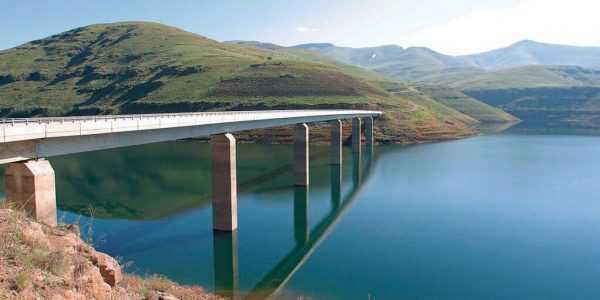
The Khubelu Bridge will be 270 meters long, with nine 30-meter spans and two abutments, while the Mabunyaneng Bridge, the shortest of the three major bridges, will be 120 meters long, with four 30-meter spans and two abutments.
According to the LHDA, the procurement for the two bridges came after the start of the Polihali transfer tunnel and Polihali dam-building bids in May and August, respectively. Each of these tenders is a step ahead in LHDA’s efforts to implement Phase II of the LHWP on behalf of the governments of Lesotho and South Africa, as well as to progress both countries’ economies.
The new Mabunyaneng and Khubelu river bridges will be positioned upstream of the two present bridges along the A1 road, providing access to Mokhotlong town over the Polihali reservoir even when the Polihali reservoir is at full capacity. Both bridges will have a width of 13.55 meters.
A section of the A1 roadway will be shifted to connect the two bridges. The major bridges will be constructed under two separate contracts: LHDA Contract 4019A for the Senqu River Bridge and LHDA Contract 4019B for the Mabunyaneng River Bridge and the Khubelu River Bridge. The three major bridges were designed by Zutari, who will also supervise their construction.
Lesotho Highlands Water Project Secures US$ 86.72M ADB Investment
The African Development Bank will lend US$ 86.72M to the Lesotho Highlands Water Project. The financing will help South Africa and Lesotho improve their water security and socio-economic growth. The multi-phase project will deliver water to South Africa’s Gauteng area while also generating hydroelectricity for Lesotho.
The project comprises harnessing the waters of the Senqu/Orange River in the Lesotho highlands through the construction of a series of dams for the benefit of both nations.
The funds will be used to build the Polihali Dam and reservoir, a 38-kilometre-long water transfer tunnel, roads and bridges, telecommunications infrastructure, and to extend electricity and other development infrastructure to Lesotho by the Trans-Caledon Tunnel Authority, a South African state-owned entity charged with financing and implementing bulk raw water infrastructure projects.
Lesotho Highlands Water Project’s Development
The new structure will supplement facilities developed during the project’s first phase. The Lesotho Highland Development Authority will oversee the project’s implementation inside Lesotho’s boundaries.
According to Dr. Beth Dunford, the bank’s vice president for agriculture, human, and social development, the two governments’ collaboration on this project centred on shared water resources from the Orange-Senqu River Basin serves the interests of their mutual development agenda while also deepening regional integration.
She went on to say that the intervention will be the bank’s first large project in South Africa’s water sector and that it will complement the AfDB’s present support in the energy and transport sectors, diversify its portfolio, and strengthen its strong collaboration with the nation.
Once finished, the Lesotho Highlands Water Project is planned to increase transfer capacity between Lesotho and South Africa to 1,260 million cubic meters per year, up from the existing 780 million cubic meters per year, allowing for greater hydroelectric power generation in Lesotho.
Greater water security in South Africa’s Gauteng area is expected, as is a boost to Lesotho’s socio-economic growth due to infrastructural upgrades and increased hydropower capacity. These advancements are intended to benefit 26 million South Africans and enhance a region that accounts for 60% of the country’s economic output.
The project in Lesotho will benefit over 85,000 people in the project region and provide over 6,000 employment over the next six years. Lesotho’s economy will also benefit from the royalty payments for water transfers. The project, which will cost US$ 2.171bn in total, will also receive a loan of US$ 213.68M from the Shanghai-based New Development Bank.
South Africa’s government will provide US$ 1.871bn in addition to a loan guarantee. The project’s first phase was finished in 2003 and launched in 2004. The African Development Bank Group’s active portfolio in South Africa consists of 23 operations with a total funding commitment of about $4.5 billion.
Work on permanent dwellings, visitors’ lodge, and associated infrastructure at Polihali Village to begin in January
After the Lesotho Highlands Development Authority (LHDA) granted the building tender to the Polihali Village Joint Venture (JV) in December 2021, work on permanent dwellings, a visitors’ lodge, and associated infrastructure at the Polihali Village is slated to begin in January. The deal, worth around M454 million, is slated to be finished in October 2023.
Partnership on the Polihali Village Project
The Polihali Village JV comprises Lesotho-based LSP Construction and South African construction firm WBHO, which worked together on the civil works and bulk utilities at Polihali and Katse, which were finished in late 2021. The permanent homes will become a Phase II legacy estate, according to LHDA Phase II divisional manager Ntsoli Maiketso.
Its design is based on energy efficiency, sustainability, and sensitivity to the rural setting. The 96 units comprise single-quarters, one-, two-, and three-bedroom residences for Polihali dam and Polihali transfer tunnel consultants and LHDA workers during and after the completion of Phase II major works.
The proposed four-star visitors’ lodge will be built on a vantage point overlooking the future dam and reservoir to maximize views of the Polihali dam. The architectural composition and layout will be affected by the nature of the terrain and site orientation. The facilities built around the Katse and Mohale dams under identical contracts for Phase I of the LHWP are still in use today and have aided the country’s tourist sector growth.
A recreational facility and a temporary five-classroom school are among the other infrastructure projects planned under the Polihali Village building contract. Under the conditions of Article 10 of the Phase II Agreement, the Phase II home building contracts were structured to allow local involvement, particularly by small and medium-sized contractors.
They were separated into four work packages: the Polihali Village, the Polihali Commercial Centre, the Polihali Operations Centre, and the Katse Village renovations contract, all given to Unik Construction in December 2021.
The procurement processes for the final two contracts are well underway. In 2015, Polihali Infrastructure Consultants was granted the contract for the planning, design, and construction supervision of the project housing and accompanying infrastructure, including Mott MacDonald PDNA of South Africa and Khatleli Tomane Moteane Architects of Lesotho. Reported April 2022
Lesotho Highlands Water Project: Tender Awarded for construction of Polihali Operations Centre
The Lesotho Highlands Development Authority (LHDA) has awarded the tender for the building of the Polihali Operations Centre to L&M, a joint venture between Lesotho business LSP Construction and South Africa-registered Mofomo Construction. The centre’s building is a vital component of Phase II of the Lesotho Highlands Water Project’s (LHWP) advanced infrastructure.
Following the delivery of the property in March, site establishment work has already begun. The M97-million project is scheduled to be finished by October 2023. According to Ntsoli Maiketso, the LHDA Phase II divisional manager, this is the third of four construction contracts to be issued, which are specially packaged to increase the involvement of small and medium-sized contractors in Phase II.
It comes on the heels of contracts issued at the end of 2021 for the development of Polihali Village and renovations to Katse Lodge and Katse Village. All three are part of the Phase II advance infrastructure, the majority of which will be finished before the dam is built.
Polihali Operations Centre Project Overview
The Polihali operations centre is a multistory office and visitor centre with an auditorium, meeting rooms, and an exhibition hall. The works also include subterranean parking facilities and outdoor works such as service connections to the property’s boundaries, road improvements inside the site, asphalt, and landscaping.
During the dam’s construction, the operations centre will serve as the engineer’s office for the Polihali Dam. Once finished, the dam will contain the LHDA operations staff’s offices and the visitors’ information centre, which will serve as a hub of LHWP information for visitors to the region.
Polihali Infrastructure Consultants, comprised of South Africa’s Mott MacDonald PDNA and Lesotho’s Khatleli Tomane Moteane Architects, were granted the contract for the project housing and associated infrastructure planning design and construction supervision in 2015. Phase II of the LHWP builds on the success of Phase I, which was completed in 2003. Oct 2022
Construction of the LHWP Phase II’s Oxbow Hydropower Scheme underway
The start of the procurement for the design and construction oversight of the Oxbow Hydropower Scheme has been a huge step for the Lesotho Highlands Development Authority (LHDA) to carry out the LHWP phase 2 (Lesotho Highlands Water Project).
The hydropower component of Phase II was the subject of further feasibility studies. The results of recommended conventional hydropower as the more workable option to meet Lesotho’s energy needs. Two Senqu River sites and Oxbow on the Malibamatso River were identified as potential sites.
Also Read: Lesotho Highlands Water Project (LHWP) Updates, South Africa
The Oxbow Hydropower Scheme was approved by the government of Lesotho in November 2021. It was also approved by the hydropower engineering, Environmental and Social Impact Assessment (ESIA). Moreover, Resettlement Action Planning (RAP) studies also gave their consent for the project.
The scope of the Oxbow Hydropower Scheme
The scope of the hydropower engineering includes A 100m high dam, two tunnels, a high-pressure steel pipe, an 80MW power plant, and a 132kV transmission line. It also involves all linked roads and accommodation, bulk power and telecommunications infrastructure, and social and environmental components.
The environmental and social parts will include studies on public health and cultural heritage. The elements will also involve terrestrial ecology, water quality elements, resettlement, and livelihood restoration elements.
This will be done to reduce the impacts of the Oxbow Scheme on the environment and communities in the project area.
Significance of the hydropower scheme
The Oxbow Hydropower Scheme is the third huge engineering component of LHWP phase 2. This is according to Tente Tente, Chief Executive of LHDA. The Oxbow Hydropower Scheme will improve Lesotho’s power security. Also, it will reduce the country’s reliance on imported electricity.
Ntsoli Maiketso, the Phase II Divisional Manager for LHDA, went on to say that the electricity produced at Oxbow adds to an additional 40% of the electricity that will be produced at ‘Muela as a result of an increased flow of water from Polihali.
After the Polihali Dam and Polihali Transfer Tunnel are completed, the transfer of water to South Africa will begin in 2028. A year later, in 2029, the Oxbow Hydropower Project will be put into operation.
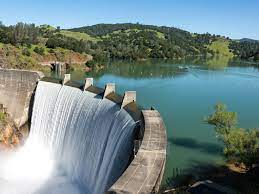
Leave a Reply